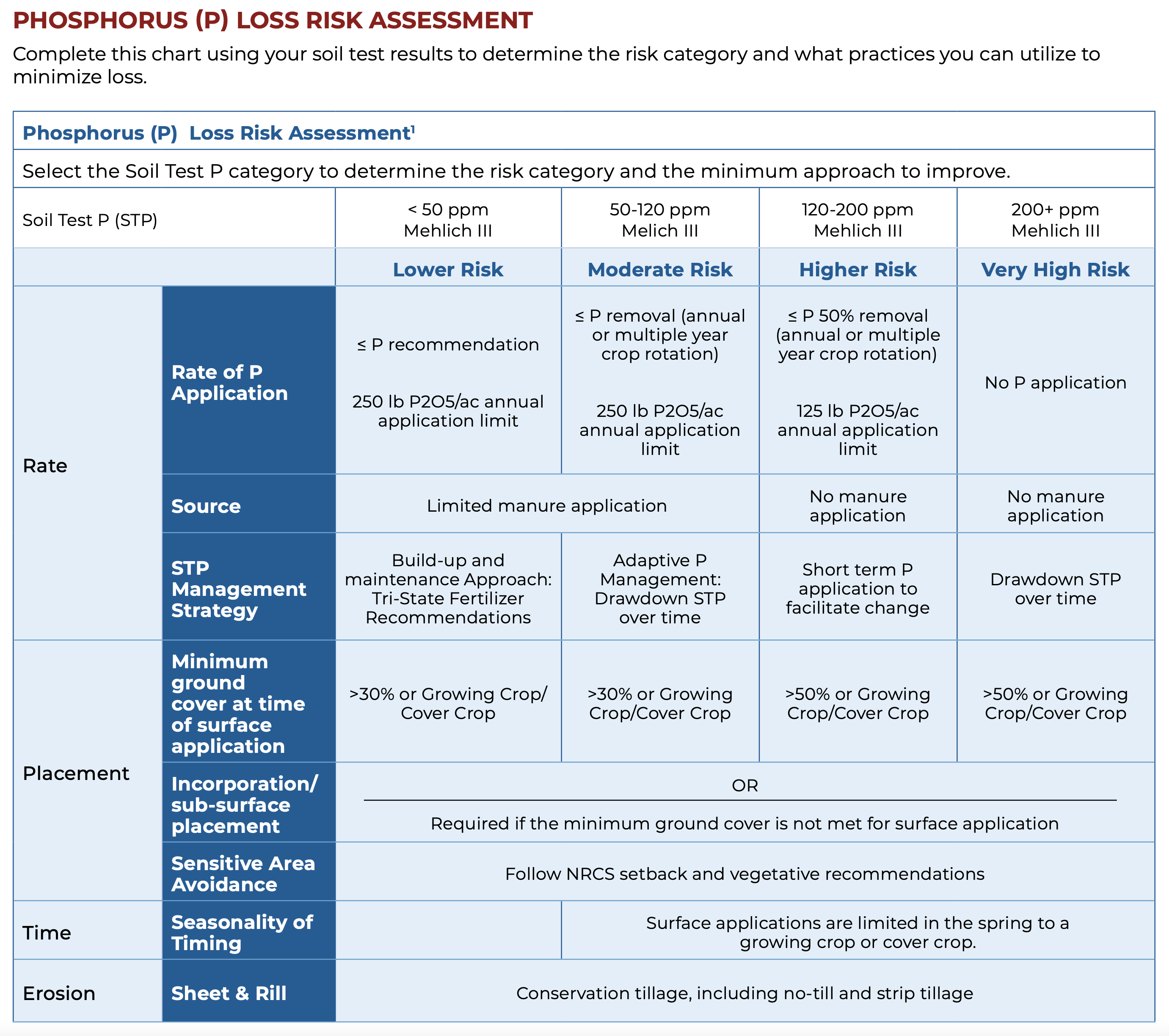Complete this chart using your soil test results to determine the risk category and what practices you can utilize to minimize loss.

Source: USDA-NRCS Ohio Nutrient Management Technical Note “Assessing Nutrient Loss Risk in Ohio”
Complete this chart using your soil test results to determine the risk category and what practices you can utilize to minimize loss.

Source: USDA-NRCS Ohio Nutrient Management Technical Note “Assessing Nutrient Loss Risk in Ohio”
The 4 R’s of nutrient management: the right source, the right rate, the right time, and the right place. Soil testing is the best place to start in order to get an accurate sampling so you can implement the 4 R’s model. Learn more with Aaron Heilers, the Demo Farms Network Project Manager.
Research being done at the Blanchard River Demonstration Farms and other related sites around the state is helping researchers determine what practices work best for reducing nutrient and sediment loss. Over the last five years, on-farm research has shown that following the 4R approach can help reduce nutrient and sediment loss:
The 4R Nutrient Stewardship principles provide proven best practices for the application of nutrients (commercial or manure) by using the right source of nutrients at the right rate and right time in the right place below the soil surface.

RIGHT TIME
Knowing when to apply nutrients is critical. Research shows the greatest potential for nutrient loss is when precipitation happens shortly after nutrient application. The time of year is also crucial – losses are lower when nutrients are applied right before planting or over the summer compared to those applied in the fall or winter.
How you can achieve Right Time:
Apply manure while the crop is growing
Manure has typically been applied in the fall after harvest or spring before planting. However, new equipment for manure application is changing this practice in order to better optimize uptake and placement.
How it works:
The in-crop application of manure can potentially replace purchased nitrogen, while also placing nutrients where the growing crop can immediately use them. The application of manure to a growing crop can also extend the manure application season, reducing the pressure to apply manure during the stress of harvest.
“Purchasing a strip-till unit and the necessary equipment cost roughly $250,000. But for an operation our size, more effectively placing fertilizer beneath the soil surface in a band where the crop can more readily access it reduced our fertilizer bill by almost one-third, or $100,000 per year.” – Bill Kellogg
RIGHT PLACE
Research is beginning to show that placing nutrients on the soil surface and leaving them undisturbed can have a negative effect on downstream water quality. By injecting or tilling nutrients into the soil, the dissolved reactive phosphorus concentration can be greatly reduced.
How you can achieve Right Place:
Subsurface placement
A crop can more efficiently take up nutrients when it is placed under the soil surface and in a band. While this type of equipment can be costly, more efficient fertilizer placement can dramatically reduce input costs – to the point that equipment can be paid off in a few years from the savings.
This article was featured in the May/June 2021 edition of Our Ohio Magazine.
Research being done at the Blanchard River Demonstration Farms and other related sites around the state is helping researchers determine what practices work best for reducing nutrient and sediment loss. Over the last five years, on-farm research has shown that following the 4R approach can help reduce nutrient and sediment loss:
The 4R Nutrient Stewardship principles provide proven best practices for the application of nutrients (commercial or manure) by using the right source of nutrients at the right rate and right time in the right place below the soil surface.
RIGHT SOURCE
To achieve desired yields most efficiently, a nutrient applicator should select a plant-available nutrient source that provides a balanced supply of essential nutrients while considering both naturally available sources and the characteristics of specific products.
How to achieve the Right Source:
Coordinate nutrient analyses with soil tests
It is important to collect and test soil samples on a consistent basis. Additionally, a nutrient analysis should be compared to the soil test results to ensure the application of the nutrients a field and crop needs.
How it helps:
Coordinating nutrient analyses with soil test results helps reduce the spread of unnecessary nutrients.

RIGHT RATE
Every crop, field and soil has its own unique nutrient needs. When farmers blanket apply nutrients, however, they run the risk of placing too many nutrients in one place and not enough in the other – with the possibility of negative impacts on either the environment or the potential of that crop. Therefore, it’s important to use technology in a way that allows the application of the right rate of nutrients for optimal results.
Solution to achieve Right Rate:
Variable or optimum rate application
Variable rate nutrient application allows crop producers to apply different rates of nutrients in different locations across the field, based on soil tests, with the help of precision technology like computers and GPS.
How it helps:
Variable rate technology for fertilizer has been used by farmers and applicators for many years. It can improve water quality and plant health, as well as optimize fertilizer inputs. Manure, however, has typically been applied at an even rate across the field. New technology for manure application equipment is changing this practice.
This article was featured in the March/April 2021 edition of Our Ohio Magazine.
On this episode of Field Day with Jordan Hoewischer, we talk with Dr. Kevin King from USDA Agriculture Research Service about his Edge of Field Monitoring program, which services as the backbone of scientific information for most nutrient and soil management decisions in the Midwest.